|
The Christmas lunch was again very successful with the usual good food and great company. As is the tradition every year, Christmas cards were exchanged to the delight of all.
0 Comments
A great weekend was had by all the participants in Olive Bull's workshop on ruling and folding pens. Olive is repeating the workshop today and tomorrow! What a dynamo! Day one saw us using ruling pens exclusively. Learning how to use the pen correctly was an interesting exercise for more than one of us. Olive very generously allowed us to use her very special pens including the gold plated Brody pen. Many envious calligraphers would have like to take it home with them. Day two of the weekend workshop saw us exploring Folded Pens. Olive had very generously made four pens for each of us, donating Frank Bull’s bamboo garden stakes for one of them. Thanks Frank! Many of the participants’ heads were still buzzing from the Ruling Pen’s workshop of the previous day where most of us had learnt many new skills. Surely, we thought, Olive would agree that we had all worked very hard and allow us a quiet, easy day. But NO! This day was just as full on, with Olive cajoling, encouraging and spurring us on. Thank you, Olive, for being so generous with your time, resources and equipment including the very precious Brody pen. We started the day making marks with the four pens Olive had made us. These included a bottle top pen, a clarinet reed pen and two pens that rival the Luthis pens. There was a general agreement that the best marks were made on the layout paper and couldn’t be reproduced on ‘proper” paper. Isn’t that always the way? Next was using our folding pen of choice and scribing a word (taken from a quote) in large letters in the middle of a page. This word was then surrounded by the rest of the quote in smaller letters. This David and Goliath layout was very effective for showcasing expressive folded pen lettering. We moved on to developing our very own alphabet. This is a challenging exercise and I think that I unintentionally ‘made up’ an alphabet that looked suspiciously like some other alphabets I have seen. We then used these letters to write a quote of our choice to see how the letters fitted together or if some adjustments needed to be made to the letterforms. Just when I thought we might have a lull we were actively encouraged to experiment with either the ruling pens or the folded pens or both together to produce pieces and patterns with or without colour. Then it was “clear the decks!” and time to turn all these examples into a Japanese style book. To Olive’s credit all but one person finished their book for the final display. What an achievement! And how lovely to have a resource that can be used and referred to as well as potentially being added to in the future. Thank you, Olive, for another memorable workshop. October 28 saw a very special day with Robin Tait, from Endangered Heritage. The subject was GOLD! We learnt so much about working with gold leaf lifting it carefully from a cushion, putting through a sieve for a wonderful effect called Zarafshan. The base for the gold was gum arabic - with or without indigo paint in it. Then we learnt how to make shell gold, and went through vast amounts of gold leaf to produce a very small amount of shell gold! No wonder it is so expensive! We produced some examples of work with gold too, ending up with painting a fine line in shell gold. This was done on top of a wash of very dilute shell gold. The ideas that came from this workshop are spinning around in our heads. Thanks Robin for a great day. Many thanks to Cherrie Grant for the photos. Our recent workshop was the Ups and Downs of Embossing led by Lyndell Dobbs. Embossing is the process of creating either raised relief images and designs in paper. Participants experimented with both hand made templates and manufactured templates. The AGM of the Society was held on Sunday and then afterward we were treated to a very interesting workshop led by Narelle Jones. Playing with Pastels proved to be very popular with some lovely worked produced. A very interesting workshop was held on Sunday at the Urambi Village Hall. The workshop, run by Pam Kemp, was on gestural writing. Pam describes it a combining the discipline of a classical script with a little variation of forms to become a more contemporary piece of art work. It was certainly an interesting challenge to most of the participants. Our June workshop was writing on "Anything But Paper". The tutor was Allira Middlebrook, whose specialty is wedding calligraphy. She led us through writing on tracing paper covers to personalise chocolate bars, writing in gold pen on coasters, (that are now fashionable as place names at tables in weddings), and writing in white paint pen on tarracotta flower pots. Even broken pots came in useful! Quite a variety. I think you'll see the results were quite impressive. Allira's script is a style of modern calligraphy which is a built-up drawn brush style. How lucky was I to get a place in the Calligraphy Society of Tasmania’s workshop Midas’s Hand – A touch of Gold Touch with Gyounghee (Hee) Lee from Melbourne as our tutor.
It was with some trepidation that I set off for Hobart for a weekend working with GOLD. I have always found any form of bling temperamental when wanting to incorporate it into my calligraphy but I was determined to learn more about it in the hope that it would lead to more consistent results in the future. I could have added Attention to Detail as a subtitle for this report, as this was the catch-cry throughout the weekend. Attention to detail starting with the right temperature and humidity in your workroom, the best ingredients for making your own gesso, the careful application of the gesso, the careful scraping and burnishing of the gesso and that was before we even got any gold near our work. We learnt about the many different varieties and qualities of gold leaf and how best to work with this expensive but beautiful material. Who knew that it is possible to get up to 20 layers of gold onto the gesso if all goes well. Over the two days we made a number of exemplar sheets, annotating as we went along, noting what worked and what didn’t and how to apply gesso with a variety of different tools (silicon brush, nib, ruling pen). We learnt how to correct mistakes and still be able to get great results once the gold was laid and burnished. Hee was a superb tutor who spent individual time with everyone to help us all produce some amazing results. She generously shared her knowledge of the history, chemistry and practical application of gold to her own work with us as she took us along the journey towards more successful illumination of our own calligraphic pieces. Thank you to the Calligraphy Society of Tasmania. It was a pleasure to meet a group of like-minded calligraphers and spend time with them in their home town learning new skills and techniques. A huge thank you also to Hee whose knowledge and ability to share it was amazing. Now for the hard part – trying to make it all work in my little room!!! Narelle Jones April 2018 workshop with Jenni Cole Eleven participants left their pens, ink and good papers at home and came along with cartridge paper (for practice) and acrylic paints. The aim of the workshop was to complete two small projects, the raw materials for which were supplied by Jenni. The first was script on coloured card which the participants were invited to take this home and turn into an A 3 size document folder. The second project was script on a handsome piece of spotted gum, to be used as an outdoor sign. Jenni’s demo made it look easy. But it proved to be difficult. Many of us blamed our failures on our brush or our cheap paint. And Jenni agreed that a really good brush (sable / ox is the best you can get) and really good paint (Jo Sonja’s is nice and creamy) will assist to make uniform and consistent shapes. The correct technique was to use pressure to make the thick strokes and then ease off the pressure and twist the brush slightly to make the tapered thin strokes. For some participants, working with the paper on an angle helped to get a consistent diagonal slope. Wetting the brush before dipping it into the paint, using a light grip, holding the writing hand high and not resting on the paper were other useful tips. Next we practiced upper case and then lower case in a script Jenni called “Free Style Script” which looks a little like a brush version of copperplate – but more relaxed in look and feel. The capitals are complex and flowery, whilst the lower case proved generally simpler and easy to master. We could cheat a bit by painting over draft penciled letters. The script has no defined stroke order, and advanced scribes may use a flowing ‘running writing’ technique whilst beginners usually favour building up each letter with several strokes. Everyone went home with the materials for their document folder and a wooden sign appropriate for a workshop, garden shed, vegie patch or car space. All it needed was a slurp of varnish to make it waterproof. Thank you Jenni for the workshop, the materials and for the lovely little ceramic brush rest she gave to each participant. We barely even noticed that in reality it was a chop stick rest. A lovely gift! And I need hardly mention that the afternoon surpassed our usual standard. Judith Wood This workshop run by Christine was described to me as being lots of fun. The evidence from the photos suggests that not only was it fun but very creative as well. |
Canberra Calligraphy Society Inc.
Like-minded people with a passion for calligraphy. Archives
January 2020
Categories
All
Inspirational People & Places
Gemma Black |
|
|
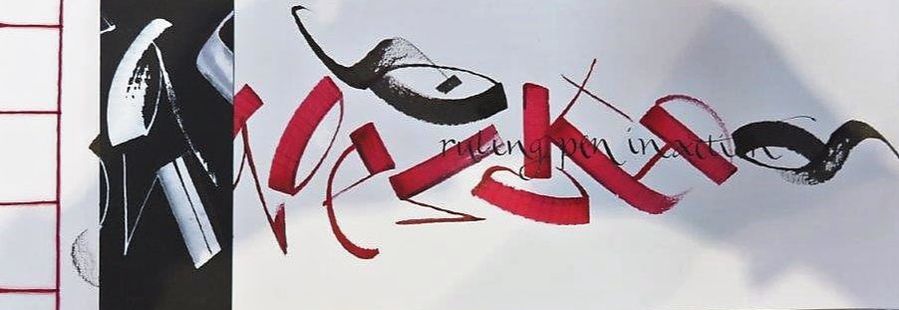
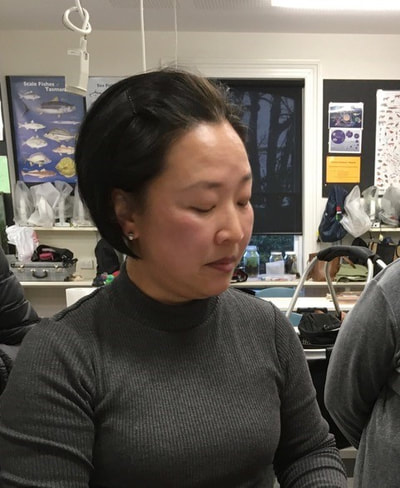
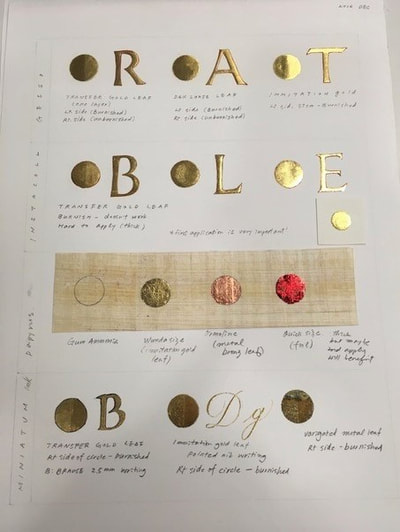
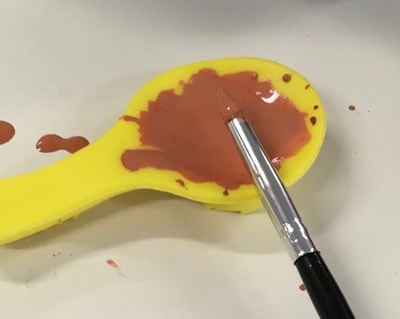
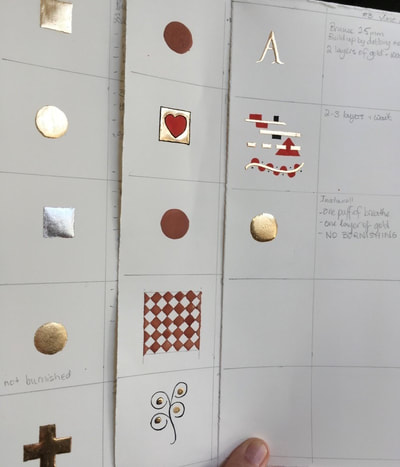
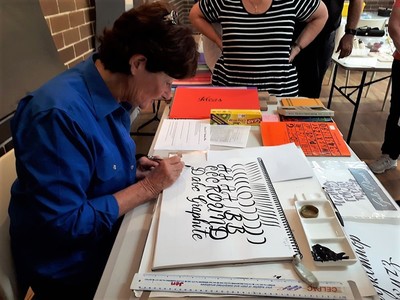
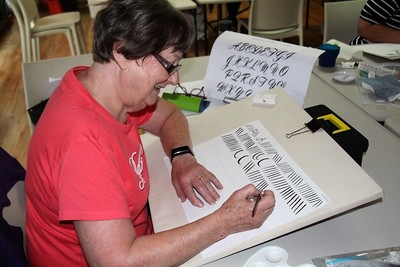
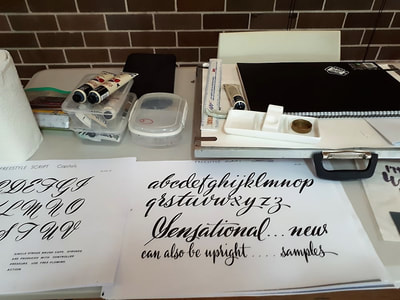
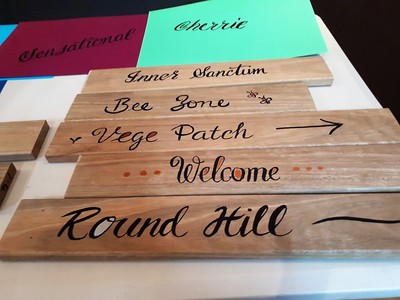
 RSS Feed
RSS Feed